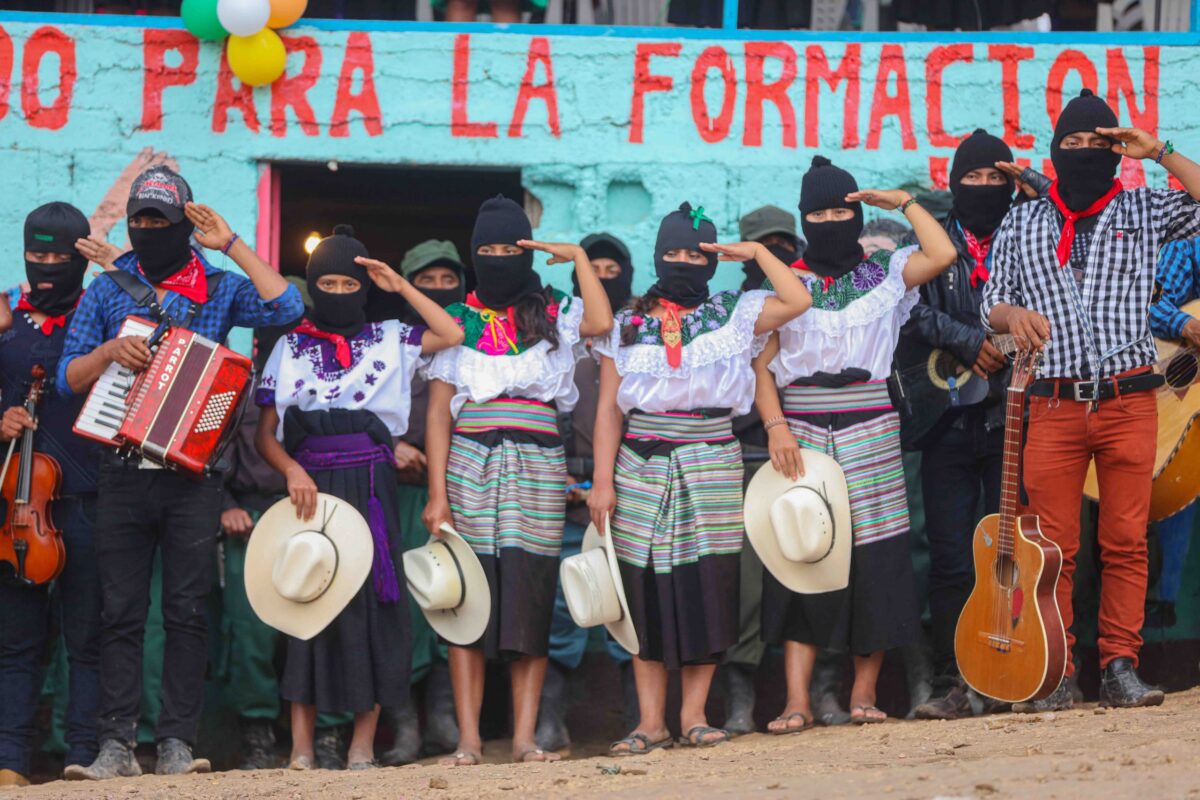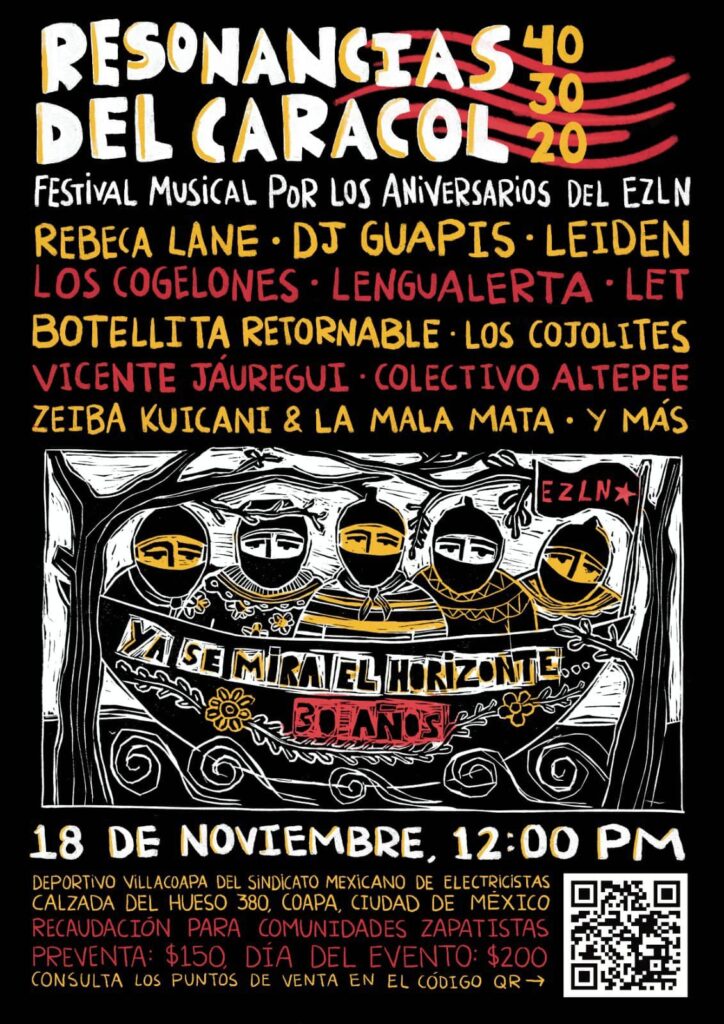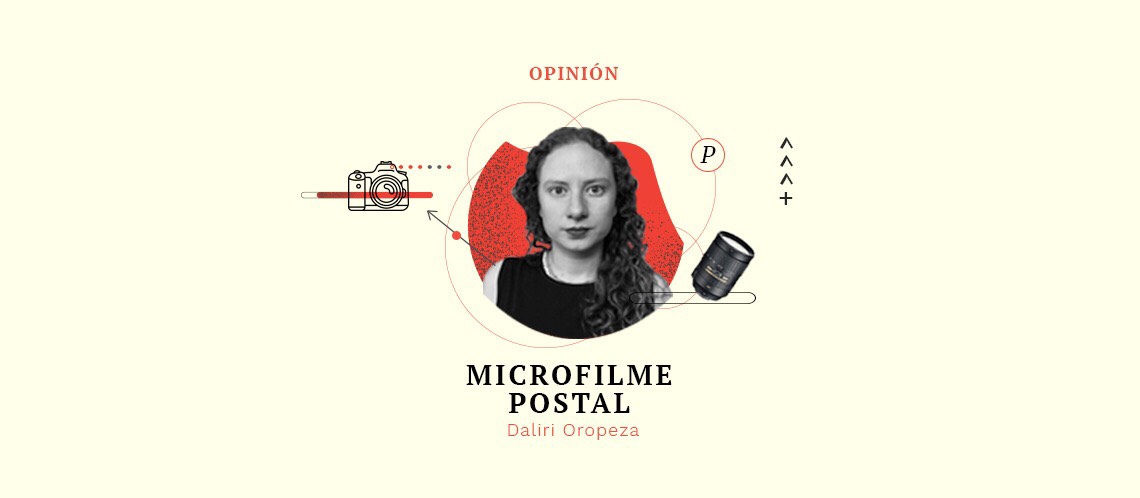The Festival Resonancias del Caracol commemorates in music the history of Zapatismo in Chiapas. In November, the EZLN celebrates 40 years of Clandestinity, 30 years since the uprising, and 20 years since the creation of the Caracoles. It is organized by the Anticapitalist University Network together with various collectives. In a communiqué, they call to “look far ahead,” to the future in 120 years

I think of Dení Prieto Stock, a young woman who decided to go underground out of social conscience. Before leaving, she left a letter to her family in October 1973 in which she reaffirms that it was not a sudden decision, but one of many years: to be part of the organization that would later give life to the Zapatista Army of National Liberation (EZLN). Since then she has been known as Maria Luisa.
She confronted the injustices and was aware of the conditions of the people in the Mexico that was marked by the student movement of 1968, the repression, massacre and persecution of young people that lasted until 1971, and which caught up with her. These realities she wrote in her letters, “there is only option in clandestine movements.” She described that this required organization and discipline.
In high school, she confronted one of the sons of President Luis Echeverría, telling him that his father was a murderer.
As a student she helped in the takeovers of land in Tlaxcala. The peasant women remember her because she taught them to read. She wrote “live for the homeland or die for freedom.” She studied nursing with guerrilla life in mind.
She was assassinated in 1974 by the army in the safe house in Nepantla. At the same time, the creation of a first guerrilla nucleus in Chiapas was being fomented.
The second group that founded the EZLN in Chiapas was made up of six people, three indigenous and three mestizos. Today, the name of Dení is mentioned in the third part of an important communiqué referring to the name of a girl, daughter of Zapatista insurgents.
Forty years ago, on November 17, 1983, began the stage of training and formation of the bases that from underground decided to take up arms in 1994, 30 years ago. They are the territories in rebellion, which 20 years ago were transformed from Aguascalientes to Caracoles, with political, educational, health, education, justice and farming structures with Mayan roots.
Today, after that 40, 30, 20, “the main cities of the southeastern Mexican state of Chiapas are in complete chaos,” according to what the EZLN describes in the fourth part of the document.
In this “today,” the political organization of the EZLN is transformed by mandate of all the Zapatista peoples that the Zapatista Autonomous Rebel Municipalities (MAREZ) and the Good Government Councils disappear, after a process of “self-critique” that lasted at least 3 years.
The EZLN announces that in the following communiqués they will state the reasons and explain the process by which they are creating a new structure of Zapatista autonomy.
“In silence we did it, without noise, calm and serene because we looked far away, as our predecessors taught us. And out there shouting at us to look only here, just a calendar and a geography. Very small what they want to make us look at. But as the Zapatistas that we are, our gaze is the size of our heart, and our walk is not of a day, a year, or a six-year term. Our stride is long and leaves its mark, even if it is not seen now, or if they ignore and belittle our path,” writes Insurgent Captain Marcos in the third communiqué.
Subcomandante Insurgente Moisés’ call is to look far into the future, 120 years from now, so that the girls who will be born then will be free, will be whatever they want to be, and with the responsibility that comes with that freedom.
I think about Dení. I think about life decisions. I think about the existentialist freedom I learned with my dad.
“We know it hasn’t been easy. And now everything is worse, and we have to look at that girl in 120 years. So we have to struggle for someone we will never meet. Neither us, nor her children, nor her children’s children, and so on. And we have to do it because it is our duty as the Zapatistas that we are,” writes Marcos.

Xavie Gálvez is a Social Anthropology thesis student at the Faculty of Political and Social Sciences at UNAM. He is part of the Anticapitalist University Network (RUA). He participates in the organization of the Resonancias del Caracol Music Festival, where artists and bands such as Rebeca Lane, Lengualerta, Colectivo Altepee, DJ Guapis, Los Cojolites, among others, will perform.
“It is important to build collective memory,” she assures. She says that the collective dialogue in the RUA allowed the generations before her to share about the concerts that were organized in the most critical contexts. In addition to the intention to put art at the center as a tool and that several members are musicians, dancers or artists.
It is worth remembering the Rock for Peafce and Tolerance festivals held in Ciudad Universitaria, the concert organized in October 1999 by Zach de la Rosa in the Palacio de los Deportes, the concert in the Zócalo during the March of the Color of the Earth in 2001, the concerts to celebrate the 20th and 10th anniversary of the EZLN.
Lengualerta is one of the singers participating in the Festival. For him it is an opportunity to “celebrate and accompany the Zapatista movement in this celebration,” at a time when the paramilitary offensive has escalated and “disorganized crime” is laying siege.
In an interview, the singer assures that “music sensitizes.” He says that in 1994, music was key to disprove the media’s stigmatization of Zapatismo, “in my experience it served to open my eyes, to bring me that other version, that other story of what was happening”.
It is to honor with music what the EZLN has walked in these years through autonomy, he says in the reflection, in Chiapas and nationally in the indigenous peoples, various struggles grouped in the National Indigenous Congress, highlights Lengualerta. Even at the international level, as was the Zapatista Journey for Life. An effective way to reach people across generations.
“This 40-year journey of this movement has been a lot of weaving and linking with so many other movements. So many other struggles, which in the end, as they say, are the same struggle for life,” says the Hip Hop singer who has accompanied the social movements in their trajectory. “It is to thank them.”
For the Zapatista movement, music has always been a companion. In the Caracoles there is no event without a group that plays everything from rancheras to rock, and everyone who attends dances. Even with the media and governmental siege, in the most difficult moments, music, dance and the arts prevail.
“Zapatismo and rock share a common structure of feeling: that which is born of resistance and the vindication of a different identity, that which comes from a profound experience of exclusion, dissidence and affirmation of what is one’s own in the face of what is foreign. Rappers, darketos, hip-hoppers, skatos, metalheads, punks, bib boperos, rastafaris-reggaeros have found in the indigenous insurrection both a cause and a theme for their songs,” wrote journalist Luis Hernández Navarro in the context of the creation of the Caracoles.
According to Lengualerta’s reflections, the EZLN is a reference “perhaps the greatest” of the struggle for autonomy and freedom.
Xavie assures that “when we share political demands through music, this sharing becomes much more powerful. Because music invites us to move, doesn’t it? Whether from dancing, from singing, music always invites us to do. And to keep on doing.”
For Xavie, the period of Zapatismo’s clandestinity is interesting because although they arrived with Marxist-Leninist ideas to the communities 40 years ago, it is the people of Mayan roots who give it the sense of struggle that they have carried for more than 500 years.
“They are forced by the same reality to change and to listen to the word and practices of the people. It seems to me that this moment is key, because it represents a change that invites us to Zapatismo, to go beyond our own reality,” says Xavie in an interview.
Regarding the third part of the communiqué, entitled Dení, and the provocative proposal of the Insurgent Subcomandate Moisés, the student notes:
“I have a hard time thinking about imagining 120 years from now and convincing myself that that imagination is not just a fantasy, but that it is a possible future. This speaks a lot about how our imagination has been co-opted. Our political imagination has been co-opted and it is very hard to do those exercises of imagining and thinking about the future,” she reflects.
“I would like to see it diverse and different, that its future in 120 years is a scenario where many worlds fit and where not only my idea of the future but also the ideas of many other people’s futures. She speaks of a future where “children can enjoy art in freedom.”
For her, autonomy inspires to sow listening, strength and confidence in our voices: “to name what happens to us, what we live, what hurts us but also what we want”. Part of the resonances they want to generate with the festival.
Tickets are available at La librería Volcana, the Rincón Zapatista in CDMX or in the socio-digital networks of the Red Universitaria Anticapitalista.
Original text published in Pie de Página. https://piedepagina.mx/mirar-dentro-de-120-anos-la-libertad/ Translation by Schools for Chiapas.
To commemorate this not at all simple but very hopeful story, from the new generations of young students a summons is born through music: The Resonancias del Caracol Festival.
Botas llenas de Tierra. Tejedora de relatos. Narro sublevaciones, grietas, sanaciones, Pueblos. #CaminamosPreguntando De oficio, periodista. Maestra en Comunicación y cambio social. #Edición #Crónica #Foto #Investigación
Ayúdanos a sostener un periodismo ético y responsable, que sirva para construir mejores sociedades. Patrocina una historia y forma parte de nuestra comunidad.
Dona















